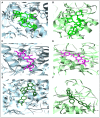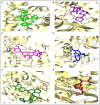In-Silico Characterization and in-Vivo Validation of Albiziasaponin-A, Iso-Orientin, and Salvadorin Using a Rat Model of Alzheimer's Disease
- PMID: 30123124
- PMCID: PMC6085546
- DOI: 10.3389/fphar.2018.00730
In-Silico Characterization and in-Vivo Validation of Albiziasaponin-A, Iso-Orientin, and Salvadorin Using a Rat Model of Alzheimer's Disease
Abstract
Alzheimer's disease (AD) is a neurodegenerative disorder characterized by dementia, excessive acetylcholinesterase (AChE) activity, formation of neurotoxic amyloid plaque, and tau protein aggregation. Based on literature survey, we have shortlisted three important target proteins (AChE, COX2, and MMP8) implicated in the pathogenesis of AD and 20 different phytocompounds for molecular docking experiments with these three target proteins. The 3D-structures of AChE, COX2, and MMP8 were predicted by homology modeling by MODELLER and the threading approach by using ITASSER. Structure evaluations were performed using ERRAT, Verify3D, and Rampage softwares. The results based on molecular docking studies confirmed that there were strong interactions of these phytocompounds with AChE, COX2, and MMP8. The top three compounds namely Albiziasaponin-A, Iso-Orientin, and Salvadorin showed least binding energy and highest binding affinity among all the scrutinized compounds. Post-docking analyses showed the following free energy change for Albiziasaponin-A, Salvadorin, and Iso-Orientin (-9.8 to -15.0 kcal/mol) as compared to FDA approved drugs (donepezil, galantamine, and rivastigmine) for AD (-6.6 to -8.2 Kcal/mol) and interact with similar amino acid residues (Pro-266, Asp-344, Trp-563, Pro-568, Tyr-103, Tyr-155, Trp-317, and Tyr-372) with the target proteins. Furthermore, we have investigated the antioxidant and anticholinesterase activity of these top three phytochemicals namely, Albiziasaponin-A, Iso-Orientin, and Salvadorin in colchicine induced rat model of AD. Sprague Dawley (SD) rat model of AD were developed using bilateral intracerebroventricular (ICV) injection of colchicine (15 μg/rat). After the induction of AD, the rats were subjected to treatment with phytochemicals individually or in combination for 3 weeks. The serum samples were further analyzed for biomarkers such as 8-hydroxydeoxyguanosine (8-OHdG), 4-hydroxynonenal (4-HNE), tumor necrosis factor-alpha (TNF-α), cyclooxygenase-2 (COX-2), matrix metalloproteinase-8 (MMP-8), isoprostanes-2 alpha (isoP-2α), and acetylcholine esterase (AChE) using conventional Enzyme Linked Immunosorbent Assay (ELISA) method. Additionally, the status of lipid peroxidation was estimated calorimetrically by measuring thiobarbituric acid reactive substances (TBARS). Here, we observed a statistically significant reduction (P < 0.05) in the oxidative stress and inflammatory markers in the treatment groups receiving mono and combinational therapies using Albiziasaponin-A, Iso-Orientin, and Salvadorin as compared to colchicine alone group. Besides, the ADMET profiles of these phytocompounds were very promising and, hence, these potential neuroprotective agents may further be taken for preclinical studies either as mono or combinational therapy for AD.
Keywords: Albiziasaponin A; Alzheimer's disease; acetylcholinesterase (AChE); in silico modeling; in vivo rat model; iso-orientin; molecular docking; salvadorin.
Figures





Similar articles
-
In silico and in vitro studies of lupeol and iso-orientin as potential antidiabetic agents in a rat model.Drug Des Devel Ther. 2019 May 6;13:1501-1513. doi: 10.2147/DDDT.S176698. eCollection 2019. Drug Des Devel Ther. 2019. PMID: 31123393 Free PMC article.
-
In silico and in vivo characterization of cabralealactone, solasodin and salvadorin in a rat model: potential anti-inflammatory agents.Drug Des Devel Ther. 2018 May 24;12:1431-1443. doi: 10.2147/DDDT.S154169. eCollection 2018. Drug Des Devel Ther. 2018. PMID: 29872266 Free PMC article.
-
Discovery of Novel Acetylcholinesterase Inhibitors as Potential Candidates for the Treatment of Alzheimer's Disease.Int J Mol Sci. 2019 Feb 25;20(4):1000. doi: 10.3390/ijms20041000. Int J Mol Sci. 2019. PMID: 30823604 Free PMC article.
-
Management of oxidative stress and other pathologies in Alzheimer's disease.Arch Toxicol. 2019 Sep;93(9):2491-2513. doi: 10.1007/s00204-019-02538-y. Epub 2019 Aug 22. Arch Toxicol. 2019. PMID: 31440798 Review.
-
Cholinesterase Inhibitors for Alzheimer's Disease: Multitargeting Strategy Based on Anti-Alzheimer's Drugs Repositioning.Curr Pharm Des. 2019;25(33):3519-3535. doi: 10.2174/1381612825666191008103141. Curr Pharm Des. 2019. PMID: 31593530 Review.
Cited by
-
UHPLC-MS Characterization and Biological Insights of Different Solvent Extracts of Two Achillea Species (A. aleppica and A. santolinoides) from Turkey.Antioxidants (Basel). 2021 Jul 24;10(8):1180. doi: 10.3390/antiox10081180. Antioxidants (Basel). 2021. PMID: 34439428 Free PMC article.
-
Decoding the Role of Astrocytes in the Entorhinal Cortex in Alzheimer's Disease Using High-Dimensional Single-Nucleus RNA Sequencing Data and Next-Generation Knowledge Discovery Methodologies: Focus on Drugs and Natural Product Remedies for Dementia.Front Pharmacol. 2022 Feb 28;12:720170. doi: 10.3389/fphar.2021.720170. eCollection 2021. Front Pharmacol. 2022. PMID: 35295737 Free PMC article.
-
An In-Depth Study of Metabolite Profile and Biological Potential of Tanacetum balsamita L. (Costmary).Plants (Basel). 2022 Dec 20;12(1):22. doi: 10.3390/plants12010022. Plants (Basel). 2022. PMID: 36616151 Free PMC article.
-
Brain Amide Proton Transfer Imaging of Rat With Alzheimer's Disease Using Saturation With Frequency Alternating RF Irradiation Method.Front Aging Neurosci. 2019 Aug 22;11:217. doi: 10.3389/fnagi.2019.00217. eCollection 2019. Front Aging Neurosci. 2019. PMID: 31507405 Free PMC article.
-
Anticholinesterase Activity of Budmunchiamine Alkaloids Revealed by Comparative Chemical Profiling of Two Albizia spp., Molecular Docking and Dynamic Studies.Plants (Basel). 2022 Nov 29;11(23):3286. doi: 10.3390/plants11233286. Plants (Basel). 2022. PMID: 36501324 Free PMC article.
References
-
- Ayaz M., Junaid M., Ullah F., Sadiq A., Khan M. A., Ahmad W., et al. . (2015). Comparative chemical profiling, cholinesterase inhibitions and anti-radicals properties of essential oils from Polygonum hydropiper L: a preliminary anti- Alzheimer's study. Lipids Health Dis. 14:141. 10.1186/s12944-015-0145-8 - DOI - PMC - PubMed
LinkOut - more resources
Full Text Sources
Other Literature Sources
Research Materials

